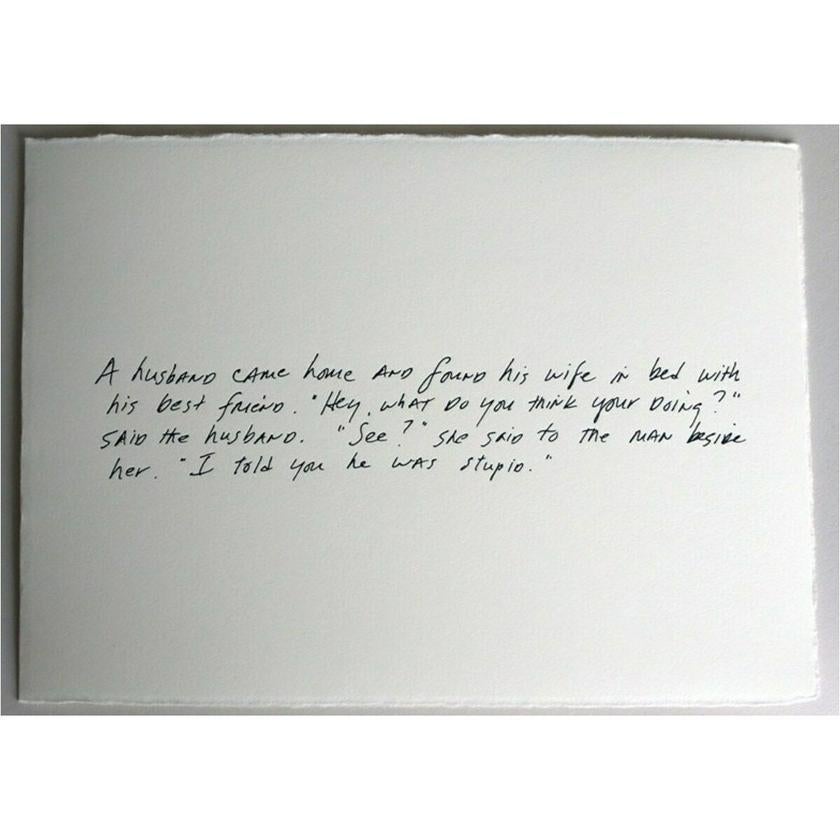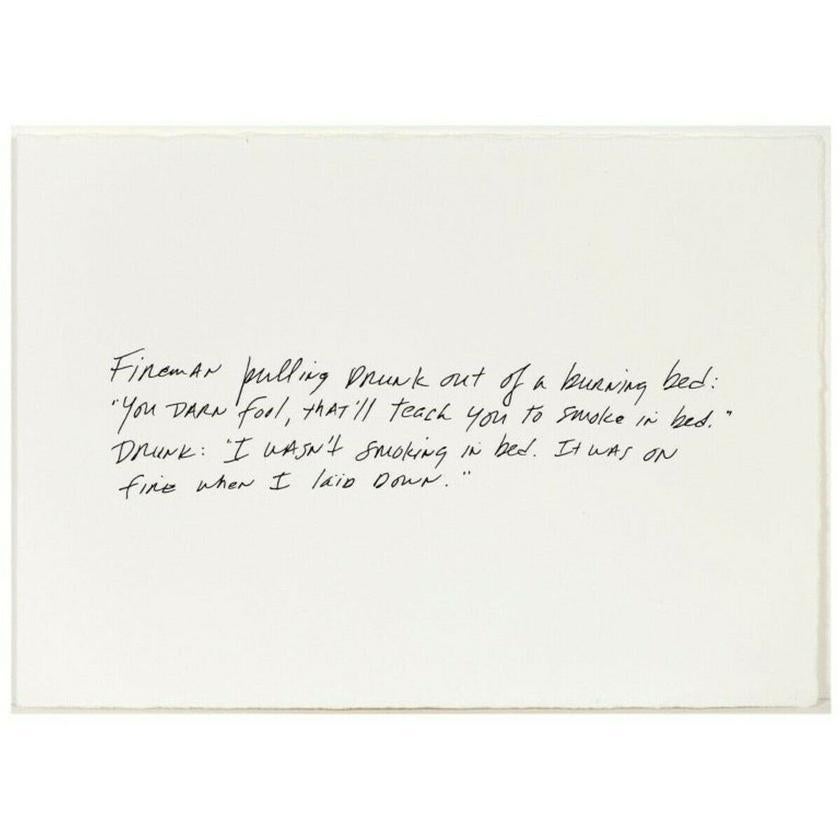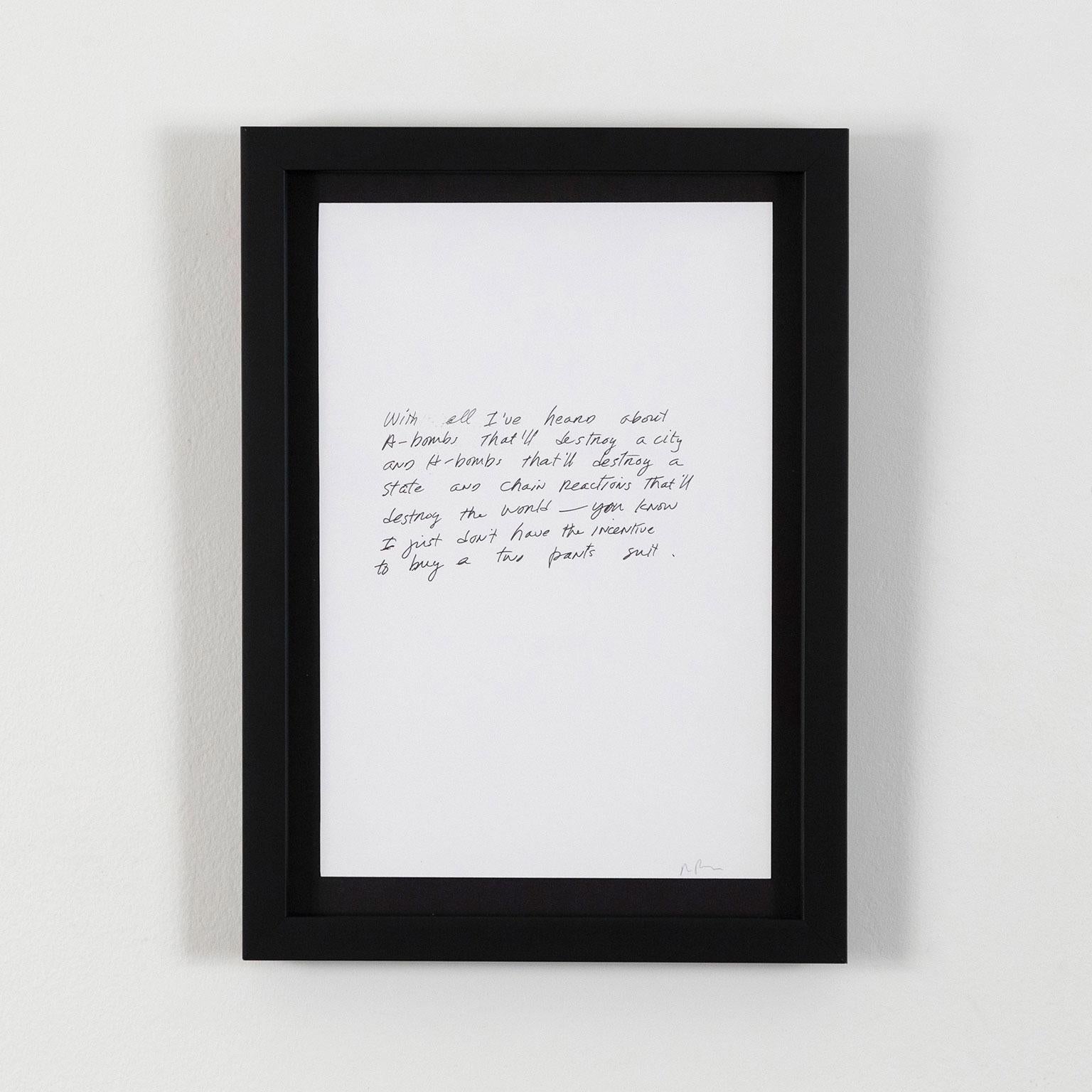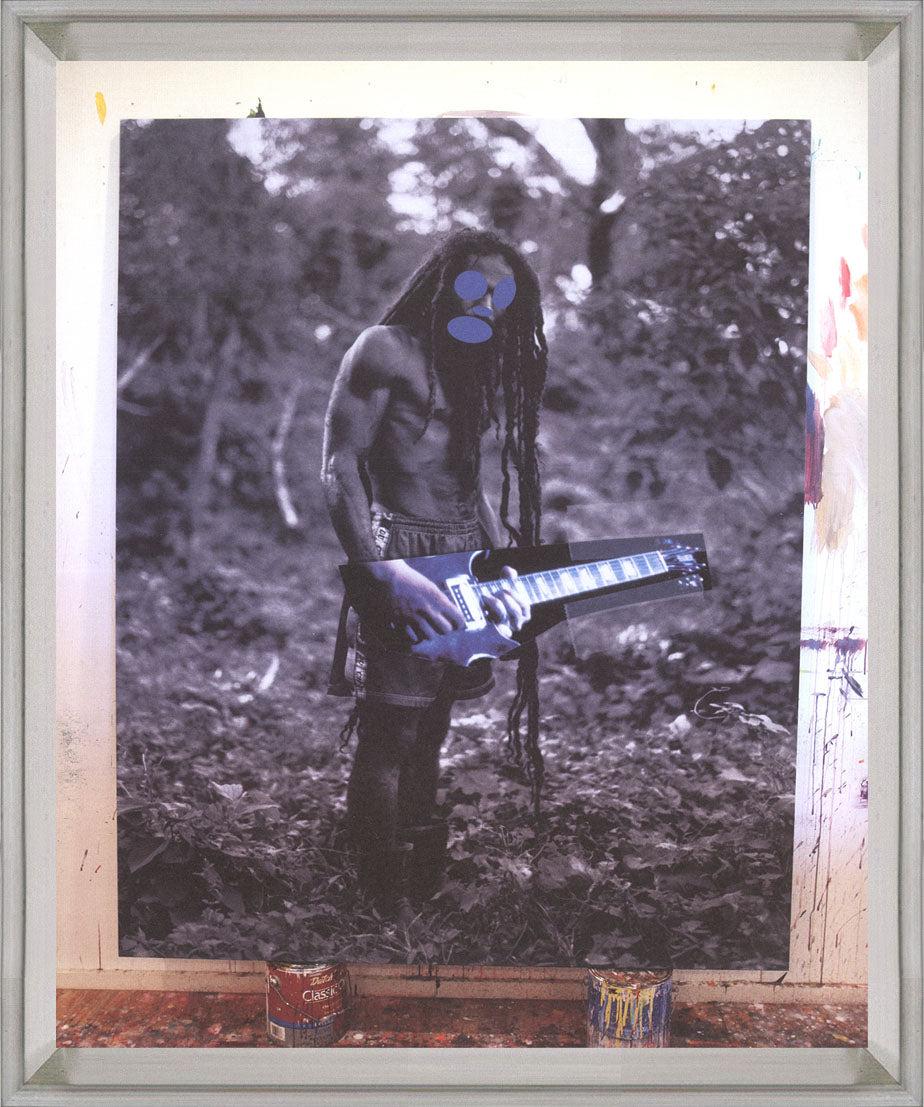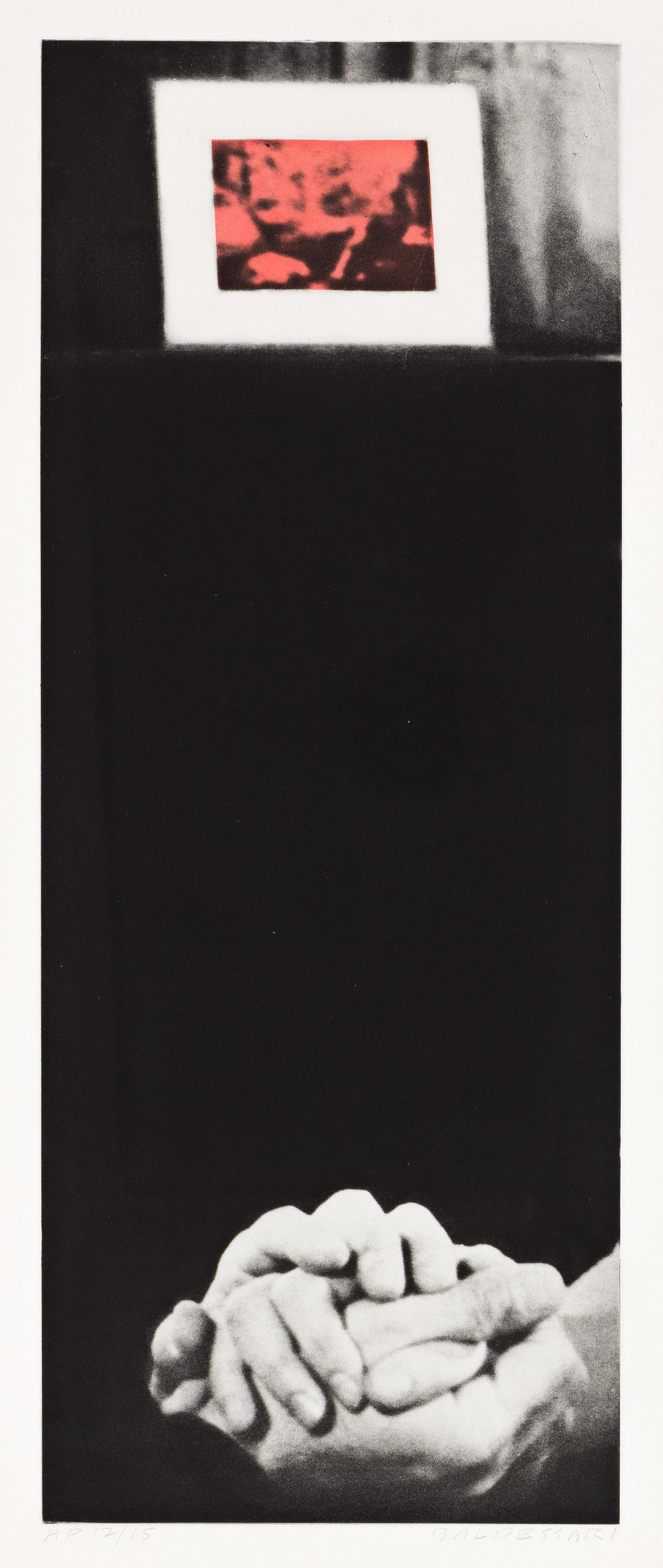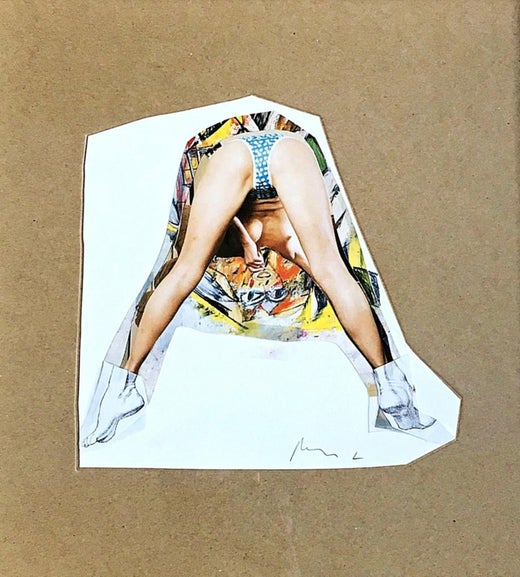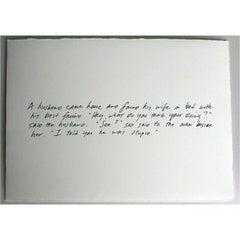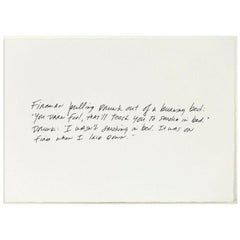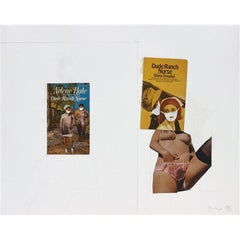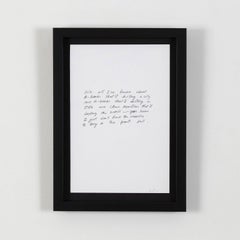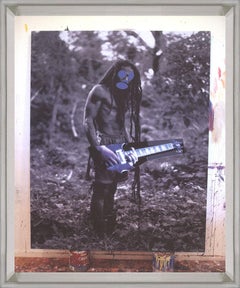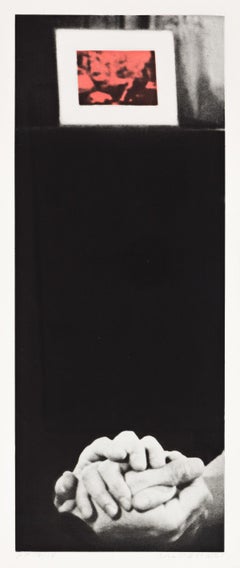Items Similar to Richard Prince, The Greeting Card Jokes #3: Canada Dry, Foil-Stamped Print, 2011
Want more images or videos?
Request additional images or videos from the seller
1 of 7
Richard PrinceRichard Prince, The Greeting Card Jokes #3: Canada Dry, Foil-Stamped Print, 20112011
2011
$4,761.09
£3,500
€4,085.51
CA$6,643.47
A$7,192.94
CHF 3,824.16
MX$86,751.85
NOK 48,090.93
SEK 44,834.44
DKK 30,513.60
About the Item
Richard Prince, The Greeting Card Jokes #3: Canada Dry, Foil-Stamped Print, 2011
Foil-stamped print, on heavy wove paper, folded.
As new condition, never framed or displayed. Hand signed and numbered by the artist, verso. Private collection (UK).
From a limited edition of 100.
Edition 91/100
6.25 x 8.5 in (15.9 x 21.6 cm)
Notes: Text image from Richard Prince's iconic Jokes series. Signed and numbered by the artist in ink on interior of card.
Looking like a classic Hallmark card, this greeting card features a joke handwritten by the artist: "My father was never home, he was always away drinking booze. He saw a sign saying DRINK CANADA DRY. So he went up there."
Incorporating jokes reflective of the “borscht belt” humor prevalent in the 1950's, Prince's Joke works tap into social preoccupations of the national subconscious. Prior to Prince's use of the jokes, many had infiltrated popular culture, gradually losing their original authors to become adopted by a largely oral tradition. Beginning in 1984, Richard Prince began assembling one-line gag cartoons and ‘borscht belt’ jokes from the 1950's which he redrew onto small pieces of paper. "Artists were casting sculptures in bronze, making huge paintings, talking about prices and clothes and cars and spending vast amounts of money. So I wrote jokes on little pieces of paper and sold them for $10 each". Following the hand-written jokes and subsequent works in which cartoon images were silk-screened onto canvas, in 1987 Prince adopted a more radical, formulaic strategy of mechanically reproducing classic one liners and gags onto a flat monochrome canvas.
Richard Prince's work has been among the most innovative art produced in the United States during the past 30 years. His deceptively simple act in 1977 of rephotographing advertising images and presenting them as his own ushered in an entirely new, critical approach to art-making — one that questioned notions of originality and the privileged status of the unique aesthetic object. Prince's technique involves appropriation; he pilfers freely from the vast image bank of popular culture to create works that simultaneously embrace and critique a quintessentially American sensibility: the Marlboro Man, muscle cars, biker chicks, off-color jokes, gag cartoons, and pulp fiction.
- Creator:Richard Prince (1949, American)
- Creation Year:2011
- Dimensions:Height: 6.26 in (15.9 cm)Width: 8.51 in (21.6 cm)
- Medium:
- Movement & Style:
- Period:
- Framing:Framing Options Available
- Condition:Sold in mint condition, as issued.
- Gallery Location:Dubai, AE
- Reference Number:1stDibs: LU160828660132
Richard Prince
Richard Prince (American, b.1949) is a painter and photographer, best known as a pioneer of Appropriation Art. Born in the Panama Canal Zone, Prince grew up in Massachusetts and moved to New York in 1977, where he prepared magazine clippings for Time-Life, spurring his interest in advertising and consumer imagery. He began creating works based on various pop culture images taken from magazines and newspapers, often re-photographing and manipulating the images in his own works. Considered by many the father of Appropriation Art, the majority of his works includes scandalous subject matter and has provoked controversy around issues of copyright in the art world. His famous Cowboys series of 1980s photographs, for example, was taken from Marlboro ad campaigns. In the mid-1980s, Prince shifted his interest from images to text, evident in his Jokes series, displaying appropriated jokes in ironic works. From his home in Upstate New York, Prince created his late Nurse Paintings series, inspired by pulp romance novels, as well as his own photographs of everyday rural and suburban life. He acquired an abandoned farmhouse near his home in 2001, which he turned into an installation site he called Second House, installing the interior with his sculptures, paintings, and his own books; the structure has been purchased by the Guggenheim Museum in New York, but was struck by lightning and destroyed in 2007. In the fall of that year, Prince’s work was the subject of a major retrospective at the Guggenheim Museum. Prince currently lives and works in Upstate New York.
About the Seller
5.0
Vetted Professional Seller
Every seller passes strict standards for authenticity and reliability
Established in 2018
1stDibs seller since 2021
237 sales on 1stDibs
Typical response time: <1 hour
- ShippingRetrieving quote...Shipping from: Dubai, United Arab Emirates
- Return Policy
More From This Seller
View AllRichard Prince, The Greeting Card Jokes #2: The Best Friend, 2011
By Richard Prince
Located in Dubai, Dubai
Richard Prince, The Greeting Card Jokes #2: The Best Friend, 2011
Foil-stamped print, on heavy wove paper, folded.
As new condition, never framed or displayed. Hand signed and numbered by the artist, verso. Private collection (UK).
From a limited edition of 100.
Edition 91/100
6.25 x 8.5 in (15.9 x 21.6 cm)
Notes: Text image from Richard Prince's iconic Jokes series. Signed and numbered by the artist in ink on interior of card.
Incorporating jokes reflective of the “borscht belt” humor prevalent in the 1950's, Prince's Joke works tap into social preoccupations of the national subconscious. Prior to Prince's use of the jokes, many had infiltrated popular culture, gradually losing their original authors to become adopted by a largely oral tradition. Beginning in 1984, Richard Prince began assembling one-line gag cartoons and ‘borscht belt’ jokes from the 1950's which he redrew onto small pieces of paper. "Artists were casting sculptures in bronze, making huge paintings, talking about prices and clothes and cars and spending vast amounts of money. So I wrote jokes on little pieces of paper and sold them for $10 each". Following the hand-written jokes and subsequent works in which cartoon images were silk-screened onto canvas, in 1987 Prince adopted a more radical, formulaic strategy of mechanically reproducing classic one liners and gags onto a flat monochrome canvas. Richard Prince's work has been among the most innovative art produced in the United States during the past 30 years. His deceptively simple act in 1977 of rephotographing advertising images and presenting them as his own ushered in an entirely new, critical approach to art-making — one that questioned notions of originality and the privileged status of the unique aesthetic object. Prince's technique involves appropriation; he pilfers freely from the vast image bank of popular culture to create works that simultaneously embrace and critique a quintessentially American sensibility: the Marlboro Man...
Category
21st Century and Contemporary Contemporary More Prints
Materials
Archival Paper
Richard Prince, The Greeting Card Jokes #1: The Fireman, 2011
By Richard Prince
Located in Dubai, Dubai
Richard Prince, The Greeting Card Jokes #1: The Fireman, 2011
As new condition, never framed or displayed. Hand signed and numbered by the artist, verso. Private collection (UK).
Signed and numbered by artist in ink on interior of card.
From a limited edition of 100.
Edition 91/100
6.25 x 8.5 in (15.9 x 21.6 cm)
Notes:
Incorporating jokes reflective of the “borscht belt” humor prevalent in the 1950's, Prince's Joke works tap into social preoccupations of the national subconscious. Prior to Prince's use of the jokes, many had infiltrated popular culture, gradually losing their original authors to become adopted by a largely oral tradition. Beginning in 1984, Richard Prince began assembling one-line gag cartoons and ‘borscht belt’ jokes from the 1950's which he redrew onto small pieces of paper. "Artists were casting sculptures in bronze, making huge paintings, talking about prices and clothes and cars and spending vast amounts of money. So I wrote jokes on little pieces of paper and sold them for $10 each". Following the hand-written jokes and subsequent works in which cartoon images were silk-screened onto canvas, in 1987 Prince adopted a more radical, formulaic strategy of mechanically reproducing classic one liners and gags onto a flat monochrome canvas.
Richard Prince's work has been among the most innovative art produced in the United States during the past 30 years. His deceptively simple act in 1977 of rephotographing advertising images and presenting them as his own ushered in an entirely new, critical approach to art-making — one that questioned notions of originality and the privileged status of the unique aesthetic object. Prince's technique involves appropriation; he pilfers freely from the vast image bank of popular culture to create works that simultaneously embrace and critique a quintessentially American sensibility: the Marlboro Man...
Category
21st Century and Contemporary Contemporary More Prints
Materials
Archival Paper
Richard Prince, Dude Ranch Nurse, Lithograph with Collage, 2008
By Richard Prince
Located in Dubai, Dubai
Richard Prince, Dude Ranch Nurse, Lithograph with Collage, 2008
Lithograph with collage with offset lithography, hand colouring, hand cutting and pencil
F...
Category
21st Century and Contemporary Contemporary Nude Prints
Materials
Lithograph, Offset
Untitled (Anxious Man) By Rashid Johnson
By Rashid Johnson
Located in Dubai, Dubai
Untitled (Anxious Man)
By Rashid Johnson
Rashid Johnson is a contemporary American artist recognized for his multimedia works, including paintings, sculptures, and installations, ...
Category
2010s Contemporary Abstract Prints
Materials
Paper
M.V 58 by Gerhard Richter
By Gerhard Richter
Located in Dubai, Dubai
MV. 58
By Gerhard Richter
2011
Signed, dated and titled in pencil
Black and white lacquer on colour photography
10 x 15 cm
Provenance: Private Collection (US)
Private Collectio...
Category
20th Century Contemporary Color Photography
Materials
Lacquer, Photographic Paper
My Relationship with Whiskey Is On The Rocks
By The Connor Brothers
Located in Dubai, Dubai
My Relationship with Whiskey Is On The Rocks
By The Connor Brothers
The Connor Brothers are a contemporary British art duo known for blending fiction with reality, often creating w...
Category
2010s Contemporary Figurative Prints
Materials
Pigment
You May Also Like
A-Bomb
By Richard Prince
Located in Toronto, Ontario
Richard Prince (b. 1949) is one of the most innovative, influential and polemic American artists. Whether you associate him with The Pictures Generation, post-modernism or Appropriat...
Category
1980s Contemporary More Art
Materials
Paper, Ink
Richard Prince 'Canal Zone' 2008- Invitation
By Richard Prince
Located in Brooklyn, NY
Paper Size: 12 x 9 inches ( 30.48 x 22.86 cm )
Image Size: 11.5 x 8.25 inches ( 29.21 x 20.955 cm )
Framed: Yes
Frame Size:
Condition: A: Mint
Additional Details: Richard Prince is...
Category
Early 2000s Prints and Multiples
Materials
Mixed Media
$600 Sale Price
20% Off
Signed John Baldessari print 1991 (Baldessari Love and Work)
By John Baldessari
Located in NEW YORK, NY
John Baldessari Love and Work 1991:
Baldessari’s Love & Work 1991, photogravure and color aquatint, features clasped hands clutching surrealistically amidst a black background. Classic, timeless Baldessari imagery that is sure to work well in any setting.
Medium: Color photogravure and aquatint on wove paper. 1991.
Dimensions: 26 x 11.5 inches.
Well-preserved and in very good overall condition. Framed in acrylic plexiglass.
One of the 15 numbered artist's proofs, aside from the general edition of 60.
Signed, inscribed "A.P." and numbered 12/15 in pencil, lower margin.
Published by Brooke Alexander, Inc., New York.
Collections:
MoMa New York
John Baldessari:
It is hard to characterize John Baldessari's varied practice—which includes photomontage, artist’s books, prints, paintings, film, performance, and installation—except through his approach of good-humored irreverence. Baldessari is commonly associated with Conceptual or Minimalist art, though he has called this characterization “a little bit boring.” His two-dimensional works often incorporate found images, composed in layers or presented as distinct pieces with an element of surprise, like a brightly colored geometric shape in the place of a face or a starkly printed sardonic caption. Baldessari has demonstrated a lasting interest in language and semantics, articulating these concerns through the use of puns or the juxtaposition of seemingly unrelated images and words, as in his 1978 work Blasted Allegories. His self-referencing photomontages and use of text have been sources of inspiration for countless artists, including Cindy Sherman, David Salle, and Barbara Kruger. Baldessari identifies his own artistic lineage, saying, "I would prefer to go to the source with Duchamp rather than credit Warhol as an influence."
Related Categories:
Surrealist. Ed Ruscha. Los Angeles. Conceptual art. Photography. Minimalist. John Baldessari prints.
Category
1990s Pop Art Photography
Materials
Aquatint, Photogravure, Lithograph, Screen
Object (with Flaw)
By John Baldessari
Located in New York, NY
Color lithograph in two parts, on two separate sheets of Arches 88 paper, these two sheets comprise two of the four parts of the original "Object (with Flaw)" publication, 1988. One...
Category
1980s Contemporary More Prints
Materials
Lithograph, Color
Angie Dickinson, hand Signed/N, Barbara Gladsone, Sothebys & Estate of Vera List
By Richard Prince
Located in New York, NY
Richard Prince
Angie Dickinson (Angie from Untitled Portfolio) from the estate of Vera G. List, 1986
Large Color Polaroid (w/Barbara Gladstone & Sotheby's Gallery Labels)
Signed and ...
Category
1980s Contemporary Color Photography
Materials
Permanent Marker, Polaroid
Untitled (from Upstate)
By Richard Prince
Located in Calabasas, CA
Artist: Richard Prince
Title: Untitled (from Upstate)
Year: 1998
Medium: Ektacolor photograph on Kodak Professional paper
Edition: 8; signed, dated and numbered (verso)
Sheet: 20 x 24 inches (50.8 x 61 cm)
Frame: Yes
Certificate of Authenticity included
This early, vintage work from 1998 by Richard Prince is part of his "Upstate" series. In 1996 Richard Prince moved to upstate New York and began a new series of creative investigations. After almost two decades of making work derived from images and phrases that already exist in popular culture, he took his camera outside and photographed the banal details of his everyday environment. Although this could be viewed as a radical departure, to Prince there is no essential difference between making photos of other photos and making photos of the world at large. He is always paying attention to what is around him with intense scrutiny.
On one level, the "Upstate" photos chronicle a landscape of economic decline in an unremarkable semirural area. Pictures of above-ground swimming pools and melancholy images of abandoned-looking basketball hoops perched on the edge of overgrown fields suggest a region cut off from the cultural mainstream. However, Prince finds quiet moments of beauty in these overlooked and undervalued features of the landscape. The "Upstate" series typifies Prince's process of making art through the reproduction and displacement of pop culture iconography, often with a touch of mordant humor, an approach that has been deeply influential in the development of appropriation art since the 1960s, and which has invited comparisons between Prince and contemporaries such as Barbara Kruger, Sherrie Levine, and Jack Goldstein...
Category
1990s Contemporary Landscape Photography
Materials
C Print
$9,600 Sale Price
20% Off
More Ways To Browse
Cartoons Screen
Richard Prince Joke
Vintage Raleigh Poster
Vintage Station Wagons
Vintage Water Ski Poster
Vintage World Industries
Warhol Trucks
Wengen Retro Poster
Wolfgang Jorg
Yusaku Kamekura
Zakopane Poster
1920 Vintage Stove
Adolf Luther
Akira Yamaguchi
Alekos Fassianos On Sale
Alex Katz Good Afternoon 2
Alex Katz Rose Bud
Alex Katz Rose
